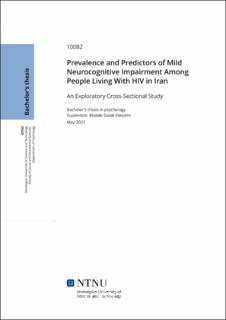| dc.contributor.advisor | Etesami, Maede Sadat | |
| dc.contributor.author | Stokke, Anna | |
| dc.date.accessioned | 2023-07-11T17:20:02Z | |
| dc.date.available | 2023-07-11T17:20:02Z | |
| dc.date.issued | 2023 | |
| dc.identifier | no.ntnu:inspera:146342237:70175707 | |
| dc.identifier.uri | https://hdl.handle.net/11250/3077762 | |
| dc.description.abstract | Humant immunsviktvirus (HIV) er en stor helseutfordring i mange områder, og spesielt i Midt-Østen og Nord-Afrika. Etter introduksjonen av antiretroviral terapi har alvorligheten av HIV-infeksjonen sunket. Likevel opplever rundt 30-60% av mennesker som lever med HIV (PLWH) nevrokognitive svekkelser som påvirker deres livskvalitet. Denne studien undersøkte forskjeller i nevrokognitiv funksjon mellom PLWH (n = 63) og mennesker som lever uten HIV (PLWoH; n = 63) i et iransk utvalg. Ved å bruke databaserte nevrokognitive tester fra Vienna Test System ble prevalensen av nevrokognitiv svekkelse i global funksjon og i seks andre domener bestemt ved å implementere reciever operating characteristic (ROC)-kurve «cut-off» t-skårer fra iranske PLWoH. Sammenhenger mellom demografiske, psykososiale og medisinske faktorer og kognitiv funksjon ble målt gjennom Spearman Rho- og Pearson-korrelasjonsanalyser. Signifikante kovariater ble inkludert i en analyse av kovarians for å undersøke nevrokognitive forskjeller mellom gruppene. Vi fant en prevalens på 59% for nevrokognitiv svekkelse i PLWH, og 19% i PLWoH, og identifiserte kjønn, utdanningsnivå, premorbid IQ og CD4+ T-celler/mm3 som signifikante prediktorer blant PLWH. Vi fant en signifikant forskjell mellom de to gruppene i global kognitiv funksjon og i alle domener bortsett fra visuell hukommelse og selektiv oppmerksomhet. Resultatene er viktige for utviklingen av et effektivt behandlingsprogram for nevrokognitiv svekkelse blant PLWH. Vi konkluderte med at videre forskning bør implementere et validert screening-program for nevrokognitiv svekkelse blant PLWH. | |
| dc.description.abstract | Human immunodeficiency virus (HIV) is a major health problem in many areas, and in the Middle East and North Africa region particularly. Following the introduction of antiretroviral therapy, the severity of the HIV infection has decreased. However, around 30-60% of people living with HIV (PLWH) experience neurocognitive impairments, which affect their quality of life. The current study investigated differences in neurocognitive function between PLWH (n = 63), and people living without HIV (PLWoH; n = 63) in an Iranian sample. By using computerized neurocognitive tests from the Vienna Test System, the prevalence of neurocognitive impairment in global function and six other domains was determined through implementing receiver operating characteristic (ROC) curve cut off t-scores from Iranian PLWoH. Associations between demographic, psychosocial and medical factors and cognitive function were assessed using Spearman Rho and Pearson correlation analyses. Significant covariates were included in an analysis of covariance to investigate neurocognitive differences between groups. We found a prevalence of 59% for neurocognitive impairment in PLWH, and 19% in PLWoH, with gender, educational level, premorbid IQ and CD4+ T-cells/mm3 identified as significant predictors among PLWH. We found a significant difference between the two groups in global cognitive function and in all domains except from visual memory and selective attention. Our results are important for developing an effective treatment program for neurocognitive impairment in PLWH. We concluded that future research should implement a validated screening program for neurocognitive impairment in PLWH. | |
| dc.language | eng | |
| dc.publisher | NTNU | |
| dc.title | Prevalence and Predictors of Mild Neurocognitive Impairment Among People Living With HIV in Iran - An Exploratory Cross-Sectional Study | |
| dc.type | Bachelor thesis | |
